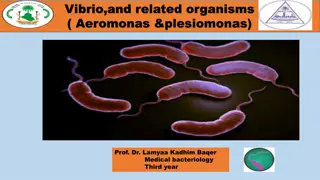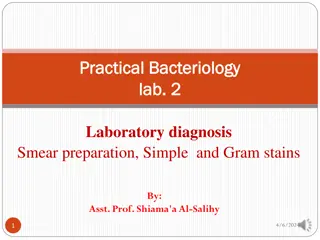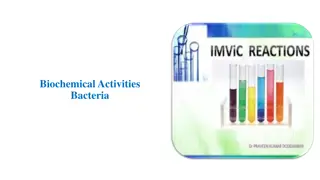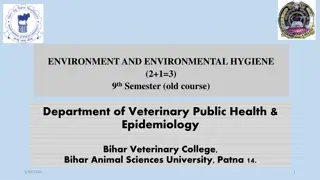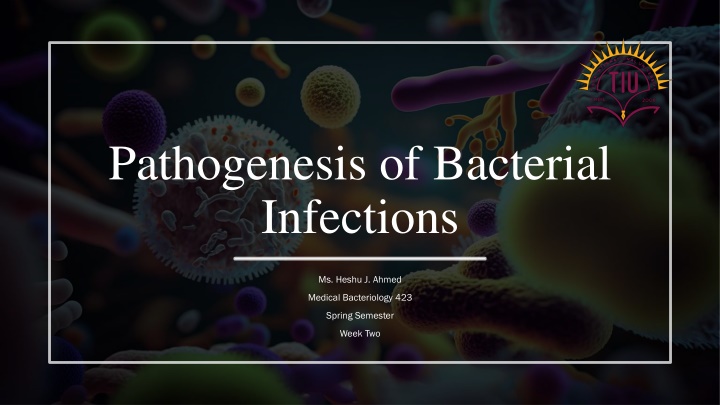
Bacterial Pathogenesis and Virulence Levels
Explore the mechanisms bacteria use to cause diseases, their adaptability, and the factors contributing to the persistence of bacterial pathogens despite antibiotic use. Learn about pathogenicity, virulence levels, and the relationship between humans and bacteria in disease transmission and survival.
Download Presentation

Please find below an Image/Link to download the presentation.
The content on the website is provided AS IS for your information and personal use only. It may not be sold, licensed, or shared on other websites without obtaining consent from the author. If you encounter any issues during the download, it is possible that the publisher has removed the file from their server.
You are allowed to download the files provided on this website for personal or commercial use, subject to the condition that they are used lawfully. All files are the property of their respective owners.
The content on the website is provided AS IS for your information and personal use only. It may not be sold, licensed, or shared on other websites without obtaining consent from the author.
E N D
Presentation Transcript
Pathogenesis of Bacterial Infections Ms. Heshu J. Ahmed Medical Bacteriology 423 Spring Semester Week Two
Overview - this lecture explores the remarkable diversity and adaptability of bacteria, facilitated by simplicity, speed, and robust genetic exchange mechanisms. - The resurgence of bacterial pathogens is attributed to the emergence of new strains and the development of resistance to antimicrobial agents in the ongoing "arms race. - The lecture focuses on elucidating the fundamental mechanisms employed by bacteria to cause disease and the genetic processes involved in their deployment.
Objectives Provide a comprehensive overview of the basic mechanisms that bacteria employ to produce diseases in hosts. Examine the diverse characteristics of bacteria, highlighting their adaptability, simplicity, and rapid genetic exchange mechanisms. Investigate the reasons behind the continued prominence of bacterial pathogens despite the use of antibiotics and the implementation of public health measures.
Definitions Pathogenicity The ability of any bacterial species to cause disease in a susceptible human host. Pathogen A bacterial species able to cause such disease when presented with favorable circumstances (for the organism). Virulence refers to the degree or intensity of the pathogenicity of a microorganism,
Levels of Virulence Low virulence Streptococcus salivarius is universally present in the oropharyngeal flora of humans. On its own, it seems incapable of disease production, but if during a transient bacteremia it lands on a damaged heart valve, it can stick and cause slow but steady destruction. Moderate virulence Escherichia coli is universally found in the colon, but if displacement to other sites such as adjacent tissues or the urinary bladder regularly causes acute infection. High virulence Bordetella pertussis, the cause of whooping cough, is not found in the resident flora, but if encountered it is highly infectious and causes disease in almost every nonimmune person it contacts. Extremely high virulence Yersinia pestis, the cause of plague, is also highly infectious, but in addition leads to death in a few days in over 70% of cases.
Humans and Bacteria Humans harbor a diverse microbiota, primarily composed of bacteria. Primary pathogens rely on replicating, surviving, and being transmitted to new hosts for long-term survival. Pathogens not adapted to humans may rely on survival in the environment for continued disease production. Biofilms, enhance extended survival by binding bacteria to environmental sites. formed by extracellular polysaccharide slimes, Endospores represent the most enduring survival form for gram-positive bacteria.
Whether a microbe is a primary or opportunistic pathogen, to cause a disease it must be able to: Enter a host Avoid host defenses Multiply and injure the host Transmit to a new host.
Each of the portals in the body that communicates with the outside world becomes a potential site of microbial entry. Mechanical barriers to microbial invasion are crucial for protection. Primarily provided by the epithelial borders of internal and external body surfaces: Skin continuously sheds contaminating organisms, inhibiting microbial growth due to low moisture, low pH, and antibacterial substances. internal surfaces, mucin secreted by goblet cells protects respiratory, gastrointestinal, and urogenital epithelium, trapping microorganisms. Secretory IgA (sIgA) secreted into the mucus and other secreted antimicrobials such as lysozyme and lactoferrin aid this cleansing process. Some bacteria excrete an enzyme sIgAprotease. How well bacteria can overcome barriers before reaching their target cells is, determined by the infective dose.
Adherence requires the participation of two factors: an adhesin on the invading microbe and a receptor on the host cell Adhesins are either directly bound to the bacterial cell surface or associated with pili. In gram-negative bacteria, the outer membrane is a major site for adhesins. Most adhesins are proteins, but carbohydrates and teichoic acids may also be involved.
Intracellular Bacteria Types: Some bacteria must live inside host cells (like viruses). These are called obligate intracellular pathogens. Other bacteria can live both inside and outside host cells. These are called facultative intracellular pathogens. How They Enter the Host Cell: Bacteria use special molecules called invasins to attach to host cell receptors (integrins). This helps them get inside the host cell.
What Happens After They Enter: Some bacteria break open the phagosome (a compartment that normally digests bacteria) and escape into the host cell s cytoplasm, where they find nutrients. Others stay inside the phagosome but neutralize its defense enzymes (like catalase and superoxide dismutase) so they can survive and grow. Special Mechanisms in Gram-Negative Bacteria: Some bacteria use special secretion systems (Type III, IV, VI) to inject proteins into the host cell. These proteins change the host cell's cytoskeleton, which helps bacteria stick to the cell surface or invade more easily.
A. The bacterial cell has an enzyme that injects it into the host cell. Some of these cause cytoskeletal reorganization, which engulfs the bacteria. In the cytosol, the bacteria lyse the vacuolar membrane, escape, and move about. B. A bacterial surface protein (Invasins) binds to the cell surface and induces its own endocytosis. In the cell, some escape (as in A), and others multiply in the phagosome. Another bacterium between cells A and B by disrupting intercellular attachment molecules. is seen invading
a. Persisting in tissues: Bacteria in subepithelial tissues encounter extracellular fluids, inhibiting their multiplication due to specific inhibitory properties. For example, most tissues contain lysozyme in sufficient concentrations to disrupt the cell wall of gram-positive bacteria. Tissue fluid is an unsuitable growth medium for many bacteria due to its low iron content. Human iron-binding proteins, like lactoferrin and transferrin, compete with bacterial siderophores for available iron, limiting bacterial growth.
1. Manipulating PAMPs The early warning and response system in which pathogen-associated molecular patterns (PAMPs) are recognized by Toll-like receptors (TLRs) Successful bacteria tend to evade these TLRs by different mechanisms: In some pathogens: the lipid A (toxic) component of LPS is simply a variant poorly recognized by TLR-4; Other pathogens are able to modulate their lipid A pattern. Gram-positive bacteria may accomplish a similar benefit by altering their cell wall teichoic acids.
2. Disrupting Complement A fundamental requirement for many pathogenic bacteria is escape from phagocytosis by macrophages and polymorphonuclear leukocytes. The most common bacterial means of avoiding phagocytosis is an antiphagocytic capsule, which is possessed by almost all principal pathogens that cause pneumonia and meningitis. These polysaccharide capsules of pathogens interfere with effective complement deposition on the bacterial cell surface by binding regulators of C3b that are present in serum. When one of these, serum factor H, is concentrated on the capsular surface, it accelerates the degradation of C3b deposited from the host s serum. Not allowing the complement pathways to continue
For the bacteria that can pass the innate immunity they get face to face with the adaptive immunity However, some bacteria have counter mechanisms to escape adaptive immunity measures as well For example, pathogenically significant surface pili and outer membrane proteins (OMPs) of N. gonorrhoeae, is the target for antigen specific antibodies produced by the adaptive immune system of the host. but the organism is continuously varying them, in a mechanism known as antigenic variation.
The successful pathogen must survive and multiply in the face of multiple host defenses. Although this is a great achievement, by itself it is not enough to cause disease. Disease requires some disruption of host function by the bacteria. Bacterial toxins are the most obvious mechanism of injury. In some diseases the only injury appears to be due to the inflammatory response to the bacteria.
References Sherris Medical Microbiology: An Introduction to Infectious Diseases. Jawetz, Melnick & Adelberg's Medical Microbiology by Geo. F. Brooks, Karen C. Carroll, and Janet S. Butel Prescott's Microbiology by Joanne Willey, Linda Sherwood, and Christopher J. Woolverton



